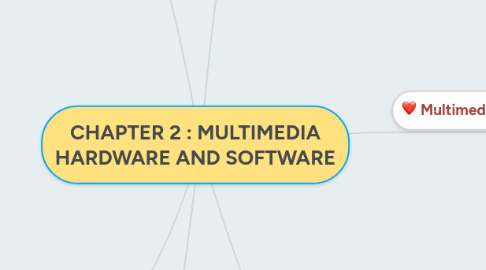
1. Multimedia Skills
1.1. Main roles in the team :
1.1.1. Project Manager
1.1.2. Multimedia Designer
1.1.3. Interface Designer
1.1.4. Writer
1.1.5. Audio/Video Specialist
1.1.6. Multimedia Programmer
2. HARDWARE
2.1. Production Platforms
2.2. Windows vs. Macintosh
2.3. Connections
2.4. IDE
2.5. USB
2.6. FireWire
2.7. Memory and storage devices
2.7.1. RAM
2.7.2. ROM
2.7.3. Hard disks
2.7.4. Flash or Thumb drives
2.7.5. CD-ROM
2.7.6. DVD
2.7.7. Blu-ray discs
2.8. Input devices
2.8.1. Microphones
2.8.2. Digital Cameras
2.8.3. Mouse
2.8.4. Optical character recognition (OCR) device
2.8.5. Voice recognition systems spoken words and commands
2.9. Output devices
2.9.1. Stereo
2.9.2. Monitor
2.9.3. Projector
2.9.4. Printer
3. SOFTWARE
3.1. Texting editing and word processing tools
3.2. OCR software
3.3. Painting tools allow you to create and modify bitmap images
3.4. Drawing tools allow you to create and modify vector graphics
3.5. Painting and drawing software features include:
3.5.1. An intuitive graphical user interface
3.5.2. Scalable dimensions
3.5.3. Multiple undo capability
3.5.4. Scalable text font support
3.5.5. Support for third-party special effect plug-in
3.5.6. Layering capability
3.6. 3-D modeling tools allow rendering of objects in a three-dimensional perspective
3.7. Image editing tools
3.8. Sound editing tools
3.9. Animation, video, and digital movie tools
4. Multimedia Development Process :
4.1. Planning and costing
4.1.1. Define the objectives and scope
4.1.1.1. Objective
4.1.1.1.1. What is the purpose of creating the project?
4.1.1.2. Scope/boundary of project
4.1.1.2.1. time to develop
4.1.1.2.2. knowledge and skills
4.1.2. Target users
4.1.2.1. To whom the project is created for?
4.1.2.2. Some background research may conducted
4.1.3. Set the contents
4.1.3.1. Obtaining rights to use existing resource
4.1.3.2. Digitizing pictures, audio, and video
4.1.4. Prepare time estimate and a budget
4.1.5. Prepare a short prototype or proof-of-concept
4.2. Designing and Producing
4.2.1. Perform each of the planned tasks to create a finished product.
4.3. Testing
4.3.1. Test your program to make sure that they meet the objectives of your project.
4.3.2. Every feature and function must be exercised, every button or link must be clicked.
4.3.3. Two Phases of Testing :
4.3.3.1. Alpha Testing
4.3.3.2. Beta Testing
4.4. Delivering
4.4.1. Final stage
4.4.2. Package and deliver the project to the end user.
4.4.3. Be prepared to follow up over time with tweaks, repairs, and upgrades.
5. The Intangibles
5.1. The intangible assets in multimedia :
5.1.1. Creativity
5.1.2. Organization
5.1.3. Communication
6. Authoring System
6.1. An authoring tool is a software package which allow developers to:
6.1.1. Organize and edit the multimedia elements of multimedia project
6.1.2. Design screen layout using templates
6.1.3. Create interactivity
6.1.4. Assembling diverse multimedia elements into a single, cohesive product
6.2. Types of authoring tools:
6.2.1. Card- and page-based authoring tools
6.2.2. Icon- and object-based authoring tools
6.2.3. Time-based authoring tools
6.3. Objects
6.4. You must be prepared to choose the tool that best fits the job
6.5. Choose an authoring tool
6.5.1. Editing and organizing features
6.5.2. Programming features
6.5.3. Interactivity features
6.5.4. Performance tuning and playback features
6.5.5. Delivery, cross-platform, and internet playability features
